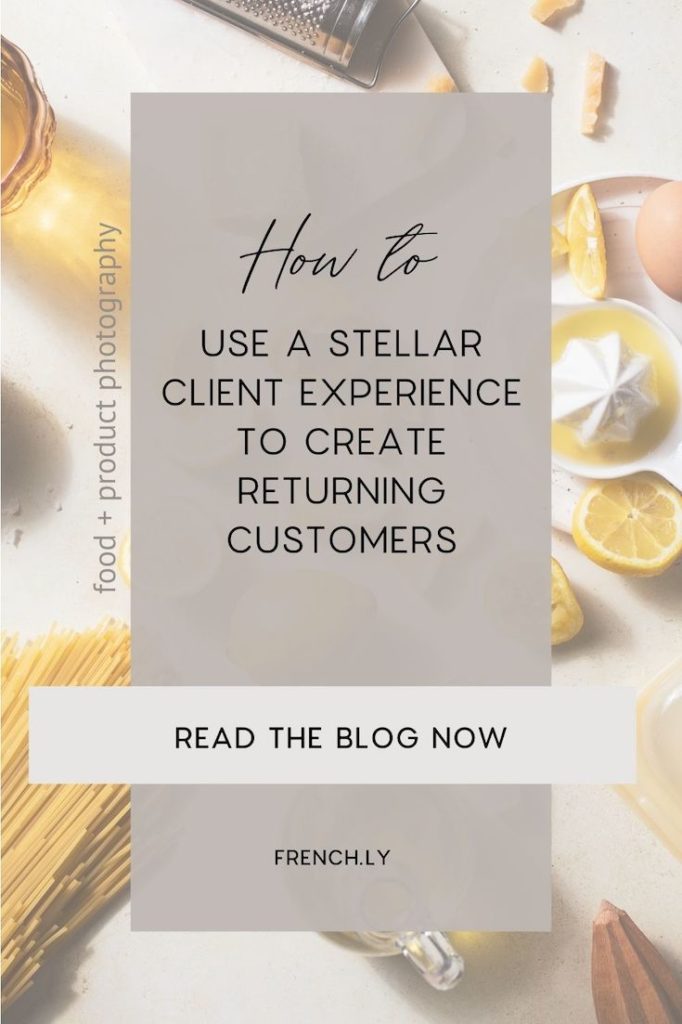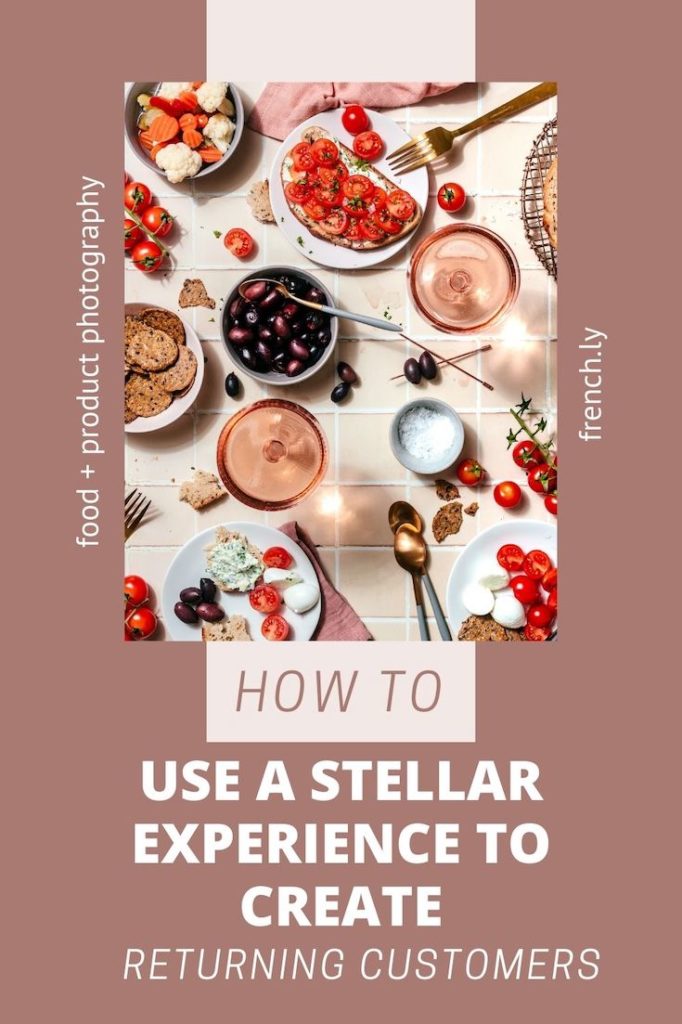In this guide, I show you how to choose who to pitch, how to find the right contact information, and how to craft a winning pitch.
PITCHING TO BRANDS AND IS THE BEST WAY TO GET YOUR IDEAL CLIENTS, AND YOU CAN DO IT WITHOUT FEELING ICKY
Gimme the Guide!
11 FOOD PHOTOGRAPHY DOCUMENTS EXPLAINED
Top Posts
11 PLACES TO SOURCE AFFORDABLE PHOTOGRAPHY PROPS AND BACKDROPS
30+ FOOD STYLING TIPS TO ELEVATE YOUR FOOD PHOTOGRAPHY
Free Resource
About Frenchly
I am a food + product photographer & educator specializing in eco-friendly and sustainable brands. When I am not working with clients, I empower creatives to start their journey by sharing my knowledge on the business of food + product photography.
How to Use a Stellar Client Experience to Create Returning Customers
May 4, 2021
Please note – some of these are affiliate links, which means I’ll make a small portion of the profit if you purchase something, at no extra cost to you! Thanks for supporting us!
Onboarding a new client is an exciting time. {You rocked your pitch! You blew that proposal out of the water!} But it’s also very time-consuming. You’re putting a lot of energy into communicating, explaining, and researching—because you’re working with this person for the very first time.
That’s why returning customers are highly desirable for small business owners: you can skip that entire part of your process and move straight into the good stuff. You have an understanding of what they like and what works for their business, as well as an established rapport with a client who already gets your process. So whenever you are working with a client who is a good fit, your top priority should be to make yourself indispensable to them. You want to be their go-to photographer from now on!
So how (and when) do you create returning customers?
How? Well, there’s no single moment when this happens. A stellar client experience is the result of lots of small efforts that happen before, during, and after a project. And if you do it right, those small efforts will appear completely effortless to your client…if they even notice them at all. Let’s dive right in and talk about what you can do throughout a new client’s project to turn them into a loyal returning customer.
Before Your Project
You can start by giving your client a great experience before they are even your client. Helpful content on your Instagram or blog not only demonstrates your expertise but it helps new clients go into your process with a foundation of understanding. There are so many topics you can cover that non-photographers will be grateful to know, like:
- Usage rights
- Image resizing
- What goes into styling a shoot
- How to get the most out of professional images
And it’s also a great way to give advice to clients who have never worked with a professional photographer, as well as clarity about your process and why it may not be the same as every other photog out there.
But the most important thing you can do beforehand is to actually qualify your clients. When you have spent so much time zeroing in on your process and building an incredible offer, you have to protect those things at all costs. That means any client who is not a good fit is potentially a waste of time, money, and other important resources.
I’m a huge advocate of pitching to brands you would love to work with, instead of just waiting for any brand to come to you. It’s how you establish yourself as “the photographer who does X,” and once you have built that reputation and understanding with your existing clients, they may also start referring you to their contacts who also need what you offer.
I also recommend that as you qualify potential clients, you look at how much regular work they are likely to have going forward. Some clients will have thousands of dollars worth of needs each month—and that’s regular work you could be landing without pitching, onboarding, and starting your research from scratch if they become returning customers.
During Your Project
What about once the contract signed, the initial invoice is paid, and the show is on the road? These three things will never steer you wrong:
1. Understand their niche
Your personal style may be part of what landed the gig, but it’s still important to know what resonates in their niche, so your images can appeal to their market. Images that sell have value, and that’s why you’re able to charge premium pricing to first-time and returning customers!
2. Be proactive about questions and concerns
Questions and concerns don’t magically disappear just because you’re nervous about voicing them. You have to get comfortable speaking up EARLY, before minor issues derail your entire project. That means constant communication…not in the sense that you are available 24/7, but in the sense that you share the information they need, exactly when they need it—and contact them ASAP when you run into a snag.
3. Set expectations and boundaries from the very start
Speaking of not being available 24/7, it’s important to establish your availability very early on in a project. For example, I do my best work in the mornings, so many times I will do a quick skim of my inbox at the beginning of the day, but not respond to anything that isn’t urgent until much, much later. It’s so much easier to stay focused when your brain can lock into one thing at a time.
But that does mean my clients don’t get a reply back the very second they message me with a question, and if they are expecting me to be available every hour of the day and on weekends, that’s bound to be off putting. So I make it very clear in my proposal, welcome guide, etc. what time frame they can expect to hear back from me when they reach out. I also manage their expectations about turnaround time the same way, so that we start off on the same page. If you need help figuring out how to put together a proposal, welcome guide and more, check out my Client Proposal Toolkit!
And remember: you want returning customers to come back with the knowledge they need!
It’s also important to be clear about image rights at this stage, because not every client will see all of your IG posts and blogs. They may still go into your collaboration without a real understanding of how they are legally able to use their images! They will be much more receptive to information about licensing before they’ve committed—because if they make it to the end of the project with one thing in mind and then you tell them at the last minute it’s not going to work that way…it’s a recipe for disappointment. And as food photographers, we only do the good kind of recipes, right?
After Your Project
Often, first-time clients have an “aha” moment after the project is over. They’re loving their images, they’re seeing a return on their investment, and they’re reflecting on how easy it was to work with you: “This experience was definitely worth what I paid!”. But they’re also VERY BUSY, just like the rest of us, and follow-up is crucial to turn them into returning customers.
I like to reach out a couple of weeks after a project is over to make sure they have everything they need. This is a great way to get feedback and glean positive testimonials that you can feature elsewhere. It also sends the message that I am invested in the success of my images—and my clients!
Continue to reach out and stay in touch. You don’t want to hound them or anything; just remind them that you are still around and still making beautiful photos. When they’re ready for more photos {which may be sooner than you think} or know someone else in their circle who is, you’ll be the first name on their minds!
Now go out and create some returning customers!
Want to learn more about building a successful food photography business and crafting an unforgettable client experience for returning customers? I’d love to connect on Instagram and add you to my email list! I share everything from systems and automations to tips on mindset. Have something to add to this blog post? Leave a comment below. I would love to talk with you!


Leave a Reply Cancel reply
| Created with Showit
| Design by Oregon Lane Studio
| Privacy Policy
© 2020 Frenchly Photography
Back to Top
THE WEBSITE
THE BLOG
Helping brands and businesses promote a happy, healthy and sustainable lifestyle through stunning food and product photography
Several of the finest suggestions I’ve stumbled across
Great list! Thank you for sharing such a great post.